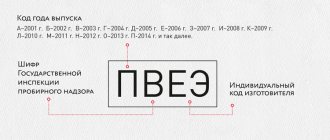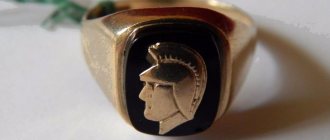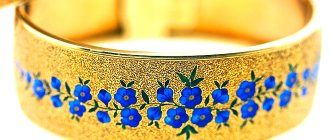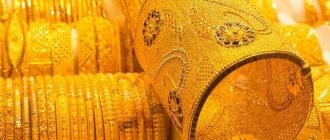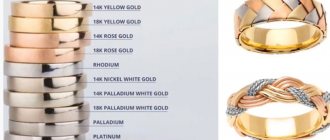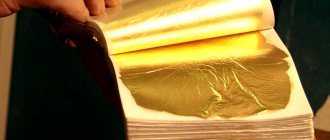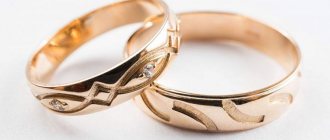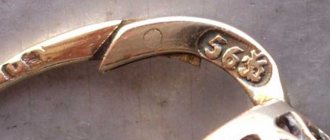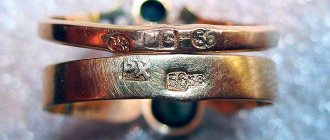Gold is the most treacherous metal in world history. It pushed people to commit crimes, people gave their lives for it, wars started because of it. However, the purest gold is so fragile that one can only be surprised at the important role assigned to it on earth. To give gold products strength, they learned to add secondary, less valuable metals to the main metal. Gold samples will tell you how much noble metal is contained in each alloy.
What is a ligature
Gold has been admired since time immemorial; it was called both fragments of the sun and a gift of the gods. However, in its original form this metal looks completely unimpressive. Pure Aurum has nothing in common with the noble metal; it has a bunch of disadvantages:
- susceptible to corrosion;
- easily susceptible to any mechanical damage;
- has a dull and inexpressive color.
Products made from such material could hardly be considered a model of perfection. And they certainly would not have been able to fit into the family category; their life would have been too short.
Without “strengthening” impurities, gold is not suitable for the work of jewelers.
They were able to correct the situation by mixing gold with slightly less noble silver or even cheaper copper. Often the “recipe” for high-quality gold involves the addition of palladium and zinc.
By combining them in different proportions, people have learned not only to create ideal alloys for making gold products, but also to give them different shades. Today, not only metal of the classic yellow color is popular. Ladies are happy to wear white, dark, pinkish and even emerald shades.
Alloys that “strengthen” gold and give it complete beauty are called alloys. Its final price depends on the ratio of the noble metal and impurities. The most expensive is the one that is almost pure Au. Financiers respect him. But jewelers don’t like it at all. They have their own idea of what standard of gold guarantees the best result.
Sales of unbranded jewelry
Since ancient times, people have collected gold objects for sale and exchange. This is a strategic reserve not only of the state as a whole, but also of each cell of society individually. Gold is the most traded commodity of all times.
If you need to sell gold items without identification marks, it is better to contact a pawnshop. They will determine how much the product costs. Pawnshops willingly accept gold without hallmarks. In general, pawnshops are created to lend money, but on security. In this case, the collateral is products made of precious metals.
You must understand that you cannot get the true value at a pawnshop. Especially pawn shop receivers evaluate whether the client can return for the collateral. This is the specificity of this enterprise. In the event that the client does not return (he has 1 month to do this), the employees must realize the deposit. But before selling, the pawnshop is obliged to present all precious goods without samples to the State Assay Office for testing and hallmarking.
Sample systems
Gold hallmark - what types of systems are there? There is no one-size-fits-all system for determining the value of a jewelry alloy in the world. In Europe and America, the amount of gold is determined in carats; this unit of measurement is used to call their sample system - carat.
We have adopted a more understandable one, metric, which involves measurement in grams.
Both systems today exist on the same terms and are recognized by jewelers around the world.
Another interesting sampling system is the spool system, which no longer exists. It was used in Rus' for just over two centuries. And you can still find family or collectible jewelry that bears such a mark. It is with this that we will begin a more detailed acquaintance with gold hallmarking systems.
Spool system
Until the 18th century, people in Rus' did not know what a hallmark of gold was and did not put a stamp on it. Jewelry and other valuable items were assessed by weight and appearance. However, due to their high cost, they were not widespread, so there was no need for special designations.
The reforms of Peter 1 also affected the jewelry business. By order of the emperor, each gold product began to be branded, burning numbers showing the content of pure precious metal. Then a system called the spool system appeared. It differed in that it indicated the content of precious metal in the original units of measurement - spools.
Officially, in the times of Peter the Great, the following types of gold samples were established: 56, 72, 82, 92, 94. Pure gold was marked with a sample of 96.
Gold of high standard, in Rus' was also called red gold.
Metric system
The spool test for pure gold was abolished already under Soviet rule, in 1927. Since then, the entire Union began to use the metric system, which was more understandable to contemporaries. Most countries left it in use even after the collapse of the USSR.
The type of Russian sample differs from that accepted in the West. Ours is decorated with an image of a woman in a kokoshnik. Some jewelers place their hallmark next to the state mark. It's called a name.
The hallmark is usually placed in the most inconspicuous place: the hallmark for a gold ring is located on the inner surface, for bracelets and chains - on the clasp. Sometimes, in order to find out what type of alloy was used to make this or that thing, you have to study it literally millimeters at a time, armed with a high-magnification magnifying glass.
Gold samples in Russia are a three-digit number that show information about how many grams of the noble metal are “hidden” in 100 grams of the alloy.
The highest standard of gold in this system is 999. The lowest is 375.
Carat system
When the borders of the USSR opened, streams of previously inaccessible information poured into us. Many things surprised me. This includes unusual double-digit numbers stamped on gold jewelry purchased during trips abroad. “There” they are used to using the karate system.
The weight of a precious metal is measured and described in carats. The numbers on the stamp tell you how much pure aurum is contained in 25 carats of the alloy. The highest standard of gold in Europe is 24, the lowest is 8.
A table of gold samples will help you navigate among antique and imported jewelry.
| Carat | Metric | Golden |
| 8 | 333 | 32 |
| 9 | 375 | 36 |
| 14 | 585 | 56 |
| 18 | 750 | 72 |
| 21,6 | 900 | 86,4 |
| 23,5 | 980 | 94 |
| 24 | 1000 | 96 |
Regional releases
Poland (silver):
| Denomination | Minting period | Alloy sample |
| 10 zloty | 1820-1827 | 868 |
| 5 zlotys | 1816-1834 | 868 |
| 2 zlotys | 1816-1834 | 594 |
| 1 zloty | 1818-1834 | 594 |
| 10 groschen | 1816-1840 | 194 |
| 5 groschen | 1816-1841 | 194 |
Poland (gold):
| Denomination | Minting time | Alloy sample |
| 50 zlotys | 1817-1823 | 917 |
| 1827 | 917 | |
| 1829 | 917 | |
| 25 zlotys | 1817-1819 | 917 |
| 1822-1825 | 917 | |
| 1828-1829 | 917 | |
| 1832-1833 | 917 | |
| Ducat | 1831 | 983 |
Russian-Polish denomination designation (silver):
| Denomination | Minting period | Alloy sample |
| 1 1/2 rubles - 10 zlotys | 1833-1841 | 868 |
| 3/4 ruble - 5 zloty | 1833-1841 | 868 |
| 30 kopecks - 2 zlotys | 1834-1841 | 868 |
| 25 kopecks - 50 groschen | 1842-1850 | 868 |
| 20 kopecks - 40 groschen | 1842-1850 | 868 |
| 15 kopecks - 1 zloty | 1832-1841 | 868 |
| 10 kopecks - 20 groschen | 1842 | 868 |
| 5 kopecks - 10 groschen | 1842 | 868 |
Russian-Polish denomination (gold):
| Denomination | Minting period | Alloy sample |
| 3 rubles - 20 zlotys | 1834-1841 | 916 |
Finland (silver):
| Denomination | Minting period | Alloy sample |
| 2 stamps | 1865-1908 | 868 |
| 1 stamp | 1864-1915 | 868 |
| 50 pennies | 1865-1917 | 750 |
| 25 pennies | 1865-1917 | 750 |
| 20 pennies | 1866 | 750 |
Finland (gold):
| Denomination | Minting time | Alloy sample |
| 20 marks | 1878-1880 | 900 |
| 1891 | 900 | |
| 1903-1904 | 900 | |
| 1910-1913 | 900 | |
| 10 marks | 1878-1879 | 900 |
| 1881-1882 | 900 | |
| 1904-1905 | 900 | |
| 1913 | 900 |
Prussia:
| Denomination | Minting period | Alloy sample |
| 1/3 thaler | 1761 | 563 |
| 18 groschen | 1759-1761 | 500 |
| 1/6 thaler | 1761 | 500 |
| 6 groschen | 1759-1762 | 305 |
| 3 groschen | 1759-1761 | 278 |
| 2 pennies | 1759-1761 | 188 |
| 1 penny | 1759-1761 | 156 |
| Solid | 1759-1761 | 63 |
Georgia:
| Denomination | Minting period | Alloy sample |
| Double abase | 1804-1833 | 917 |
| 1828 | 868 | |
| Abaz | 1804-1831 | 917 |
| 1828 | 868 | |
| Semi-base | 1804-1833 | 917 |
Baltics:
| Denomination | Minting period | Alloy sample |
| 96 kopecks | 1756-1757 | 750 |
| 48 kopecks | 1756-1757 | 750 |
| 96 kopecks | 1756-1757 | 750 |
| 48 kopecks | 1756-1757 | 750 |
| 24 kopecks | 1756-1757 | 750 |
| 4 kopecks | 1756-1757 | 750 |
| 2 kopecks | 1756-1757 | 396 |
Tauride coins:
| Denomination | Minting period | Alloy sample |
| 20 kopecks | 1787 | 729 |
| 10 kopecks | 1787 | 729 |
| 5 kopecks | 1787 | 729 |
| 2 kopecks | 1787 | 729 |
Polish-Lithuanian Commonwealth:
| Denomination | Minting period | Alloy sample |
| Tinf | 1707-1709 | 500 |
| Half-inf | 1707 | 500 |
Article last modified: 02/07/2018
Other articles
From 375 to 999: what samples exist in modern Russia
What is the best standard of gold and what types are there? Each gold alloy has its own price. To determine exactly how much capital is stored in a jewelry box, you will need information about what the gold standard means.
It will also be useful for simply lovers of this metal: ladies who adore jewelry or collectors. Having familiarized themselves with it, they will know exactly all the hallmarks of gold, which gold hallmarks are suitable for jewelry or collectibles.
375
This alloy contains 37.5% Au. Another 63% is a mixture consisting of cheaper copper and silver. The color of the alloy depends on which of these two metals predominates. Any shade of yellow indicates the prevalence of silver, reddish – copper.
375 gold is quite durable.
Products made from it hold their shape perfectly, do not bend or break. However, there are disadvantages: this alloy is easily oxidized, and over time, iron sulfide appears on the surface.
The only advantage can be considered the cost: products made from such an alloy are an order of magnitude cheaper than all other types of gold.
500
The rarest of the existing gold samples that exist in Russia. Contains 51% aurum. By increasing the composition of the precious metal, jewelers were able to solve the problem of oxidation: a similar incident will not happen to a product that bears the “500” mark.
However, it was not possible to significantly improve the external one. The comments mainly concern the color. Regardless of the percentage of silver and copper, it turns out inexpressive.
583
Currently not produced. It was completely absorbed by the 585 alloy.
585
It is believed that this is the best standard of gold, most suitable for jewelry. By the way, not only Russian masters adhere to this point of view. All over the world they prefer to use alloys with approximately the same content of precious metal.
59–60% gold is a good proportion and provides an attractive appearance to the alloy. Jewelers, and after them consumers, were finally satisfied with the color of the products and their characteristics. Jewelry and other items turned out to be beautiful, durable, and resistant to various tests. They do not oxidize, do not fade under the influence of direct sunlight, and stoically withstand frost.
At the same time, the relatively small content of the precious metal makes it possible to set quite humane prices for such gold.
Jewelers have another reason to especially value 585 gold. The fact is that it is very malleable, from it you can forge a figure that will satisfy the most demanding imagination.
The ligature in this alloy consists mainly of four metals; nickel and palladium are added to silver and copper.
750
This is the highest standard of gold that is of interest for jewelry. Approximately three-quarters consists of pure aurum. Everything else is a ligature, alloyed mainly from silver, a small amount of palladium and copper.
Sometimes admixtures of other metals are added here, which allow you to play with the color of the final product. Depending on which minor metal predominates, the alloy can be the usual yellow, rich red, or even dark green. Although some connoisseurs are ready to shell out large sums in order to take possession of jewelry in an unusual color: emerald, black, dark blue.
This gold still retains its quality characteristics. It is quite durable and resistant to time and external circumstances. It is processed in the best possible way and readily takes on any form conceived by the master.
They especially like to use it for cutting precious stones.
The price, due to the large amount of noble metal, is a contraindication for mass production. Exclusive expensive things are made from the alloy.
958
It is no longer possible to make jewelry from such an alloy. There is a lot of gold here, about 97%. It makes the product loose and easily deformable. Connoisseurs of the precious metal sometimes order special coins made from it or other expensive, most often, collectible items.
The high cost of the material allows these items to be used not only as expensive souvenirs, but also for accumulating and storing savings, which, if necessary, can be converted into any currency.
999
This is the highest standard of gold in the world.
It is also called “four nines” because it contains 999.9% of the precious metal. This is the most expensive alloy in the world. However, it is completely unsuitable for making anything. Pure gold, 999 purity, is a brittle and brittle metal; it is completely unsuitable for use in any form.
Although previously wealthy people ordered wedding rings for themselves. However, in order for these symbols of marriage to serve their owners for any length of time, they were made very massive, wide and thick. On average, such jewelry weighed about seven grams and must have been very disturbing to those who decided to put it on the ring finger.
Now gold bars of a certain weight are smelted from gold of the highest standard and used for investing money. Most often, they are simply stored in safe deposit boxes, providing their owners with the safety of their funds.
Composition and properties of metal
The general composition includes different proportions, but high-grade products always contain at least 90% pure gold.
Red metal is almost no different from pure raw materials in terms of functional parameters - it is malleable, soft, fusible, and has a tendency to abrasion and deformation even when tested the “old-fashioned way” - by squeezing between teeth. An impression of the teeth remains on the surface of the chervonets.
Today, red metal is used mainly in the creation of jewelry. You can also find products made from it inside various museums, where ancient coins and family jewelry are displayed.
The material enjoyed particular success in the manufacture of wedding rings.
Which sample can be considered the best?
In Russian there is a figurative expression - “gold of the highest standard.” This is how they talk about something superlatively beautiful and expensive. Although, as you can see from the information above, it is pure gold that is not suitable for anything other than lying in a safe deposit box. So it’s probably impossible to say with certainty which standard of gold is better. Each option has its undeniable advantages. As well as the shortcomings.
Let us only note that alloys marked “585” and “750” are more suitable for jewelry production. Things made from them can be stored for a very long time and, in the end, even acquire the status of heirlooms.
For investing money, the best ingot is the one with the most expensive purity of 999 on it. The price for it is quite stable; in recent years there have been only minor fluctuations. So this metal can guarantee the safety of capital.
Identification methods
The oldest and most common branding method is mechanical. In this case, the impression on the product is made manually - a special tool is placed on the surface of the metal, which is struck with a hammer. Later, a similar operation began to be carried out using a machine. The mark comes out clear and lasts for a long time. However, with this method the product may become deformed.
With the development of jewelry technologies, spark and laser methods began to find widespread use. Such methods require more thorough preparation of the metal.
The mark on gold products, made using a laser, is of high quality and can be applied to any relief. The disadvantages include instability - with daily contact of the brand with the surface of the skin, its lifespan does not exceed 5 years.
The assay office is responsible for setting samples on jewelry. This applies to both private workshops and large jewelry enterprises. An individual can also contact this institution to test a piece of jewelry. For this purpose, the offices have special reception days. The procedure is carried out within several working days.
